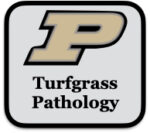Summer patch hits hard in early August; fall rust outbreaks causing orange shoes; cool temperatures allowing a head start on recovery plans.
Weather
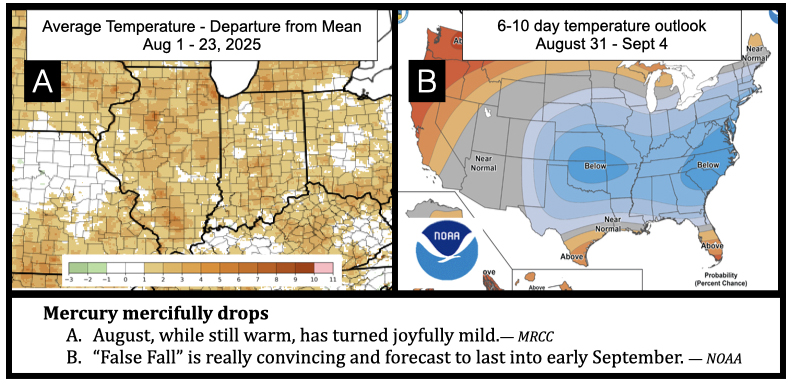
August in the region started cool, got back to summer hot, and now dare I say it feels like fall. This “false fall” in Indiana certainly is convincing as a stagnant high-pressure dome descended from Canada last week. Today was the coldest August 26 in the last 43 years with lows in the 40s across upper and middle Indiana. Recent temperatures have been 10-12 degrees below normal and brought monthly average temperatures back to near average after a solid span of heat with 90F + highs from August 8 – 19. The total number of days >= 90 F in Indy is 29 days, 5th most in the last 15 years (2018 – 38 and the brutal three year stretch from 2010 – 37, 2011 – 42, and 2012 – 51 days). With the prescribed forecast indicating no major shifts, perhaps the summer spikes are finished and the time is nigh to get into recovery mode.
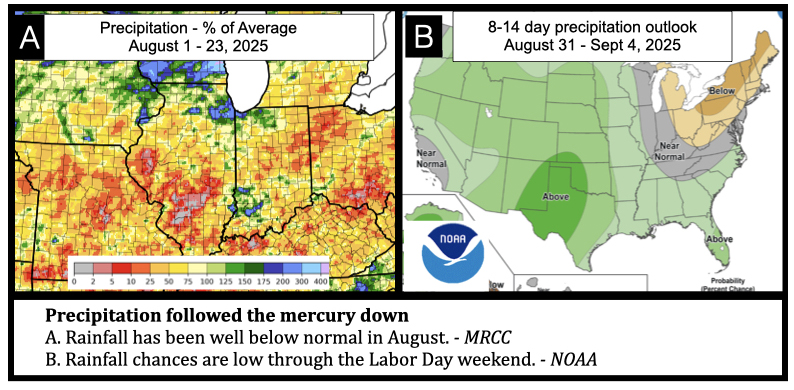
Along with the decline in heat, rainfall has also fell off a cliff. Areas in central and eastern IN are running Some non-irrigated turfgrass areas are starting to feel the pinch of drought dormancy, particularly if on substandard soils. Morning dews have been so heavy in some areas that perhaps some supplementation has occurred, but a cool rain in north central IN and central Illinois would be welcome. The forecast doesn’t indicate any major system coming through in the next week, which is good news in keeping our cool air but bad news for garnering significant rainfall.
Summer Patch on Kentucky Bluegrass Lawns/Roughs & Bentgrass Putting Greens
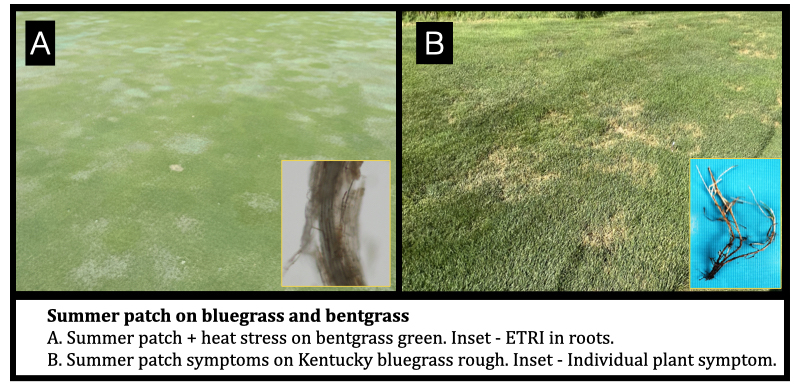
Summer patch arrived with numerous samples to the diagnostic lab starting in early August. Kentucky bluegrass on lawns and golf course roughs was severely affected as were numerous bentgrass putting greens broadly throughout the region. These summer patch infections of roots, stolons and rhizomes likely started occurring and accruing much earlier in the summer. Some of the samples displayed dark necrosis up into the leaf sheath and crown tissue.
Summer patch, necrotic ring spot, spring dead spot and take-all patch are caused by a group of pathogens known as the ectotrophic root infecting, or ETRI fungi. This group includes fungi in the genera Gaeummanomyces, Ophiosphaerella,and Magnaporthiopsis (aka Magnaporthe), and all have similar dark runner hyphae that are observed in nearly all stressed root samples. This complex, however, may also include pathogens that haven’t been studied in detail and may require a different management strategy.
Fungicide effectiveness for soilborne pathogens can be inconsistent due to a variety of factors including timing, delivery (requires post application irrigation) and organic matter composition (ties the fungicide up). Several turfgrass managers explained their exasperation that a preventive program was in place, started in the 65 F spring window, applied according to all recommendations and watered in. IPM strategies that maximized turfgrass health and targeted the pathogen (i.e. ammonium sulfate and manganese sulfate in the spring) may have also been needed, but also may have not completely turned the tide. Unfortunately, the combination of summer environmental stresses often means very light straws can break turfgrass backs. Even light ETRI infections on greens and lawns that would’ve been tolerated in previous years may have been the final straw in yielding disease symptoms in this one.
Rusts Starting to Roll
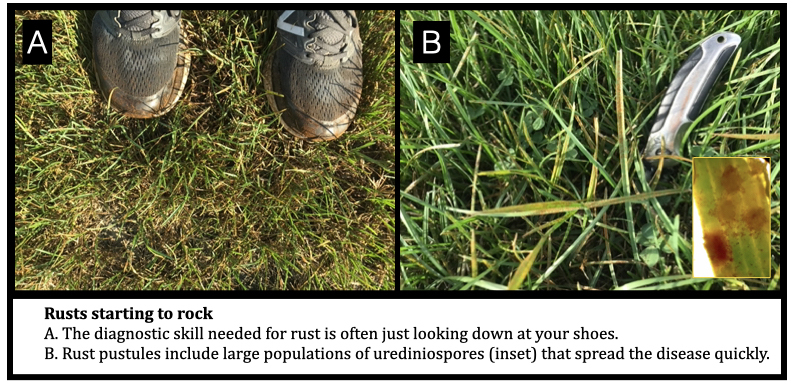
Rust on turfgrasses is a common mid-summer to early fall occurrence in the region and orange dusty shoes have raised some alarms in the last few days. The disease is caused by Puccinia spp., the same fungal genus that causes significant crop losses in wheat and other cereals throughout the world. Fortunately, turfgrasses are not needed for food and we are not interested in harvesting seedheads.
These pathogens are quite complex and can have several spore types on different alternate plant hosts. On turfgrass, the uredinia stage is most prolific with masses of pustules on leaf blades containing thousands of powdery orange spores that disperse, infect and spread the outbreak. Several types of rusts occur on turfgrass (stem, stripe, crown and leaf) and although all cool-season turfgrasses can be affected, higher cut Kentucky bluegrass and perennial ryegrass often have the most severe outbreaks.
Rusts rarely completely kill turfgrass but can cause severe thinning on newly seeded stands such as in sod fields. Rust outbreaks that reduce plant density most likely occur during a drought, low fertility or other stressor now on weakened plants after summer. Although a nuisance on shoes and pants legs, rusts are normally best treated through proper irrigation and may be an indication that the lawns need to be fertilized.
Recovery Plan
After a long hot summer, one might be squeamish to think of getting into aggressive recovery mode. The forecast, however, looks ripe to do so and September is just around next week’s corner. Not all turfgrass is managed equally, so here’s a few recovery hints for getting golf vs. lawn height turfgrass back into shape.
Golf Greens – Needless to say, this was a rough summer for golf putting greens. Some considerable loss of putting green stands occurred. If your greens struggled, know that you were not alone. This was our busiest season in the diagnostic lab since I’ve been at Purdue, correlating directly to the tough environment this season.
Overseeding and renovation of extremely damaged areas is ongoing, but don’t forget about the state of putting green health after this summer. Roots are still at their shortest and metabolism, while improving, is still weakened. When these cooler temperatures hit, bentgrass putting greens may have the environmental cues to grow, but not enough resources to pay that bill. Even if greens look fine and are growing, their hidden root bunions are still sore after that summer marathon. So perhaps help out by:
- Supplementing a tad more nitrogen in the spoonfeed (which will also help with anthracnose)
- Stretching PGR intervals just a bit longer in this cooler weather
- Lightly topdressing to, in effect, reduce mowing height without touching the bedknife
- Burping the rootzone a little with a solid tine.
Lawns/Roughs – The Canadian phrase “pitter patter let’s get at ‘er” sums up how to deal with lawns now. On lawns thinned out with disease and heat stress, the cooler weather in the region is providing a golden opportunity to get started.
- Aerify or verticut lawns dense with water and nutrient blocking thatch, particularly Kentucky bluegrass.
- Overseeding thinned lawns with good quality seed can be done now with the advantage that broadleaf weed control may still be able to be timed later this fall after seedling emergence (check the herbicide label). Promote good seed soil contact by lowering mowing height and even scalping severely declined lawns if needed. On non-irrigated lawns, perhaps wait to overseed until a storm is forecasted (perhaps next week).
- If lawns have gone since May without fertilization, now is the time to give them a kick of nitrogen to help them grow out of the summer doldrums. Even if you’ve been supplementing throughout the summer, the fall season is best time for lawn fertilization to restore density and quality. Dollar spot on Kentucky bluegrass, which is often a fall issue, is an indicator disease that the lawn needs nitrogen.
Fall Events
Open Learning Opportunity
Turfgrass IPM Module – Understanding Turfgrass Insecticides
Dr. Doug Richmond has created this online module course to allow you to earn CCH education credits (with six additional states also given approval) from the comfort of your favorite recliner. This education is delivered in a creative, modern format and is the first of a series of pest management lessons to be rolled out in the coming months.
MRTF Day of Service – September 23
Lend a hand and your expertise to help beautify spaces and enhance the community in Indiana. This year the MRTF will be having a day of service from 10 am – 3 pm on 9/23 at Abby & Libby Memorial Park.
MRTF Annual Golf Day Fundraiser – October 13
Support turfgrass research and education while playing the fantastic Warren Golf Course at Notre Dame.
Turf & Landscape Seminar – November 19 & 20
Mark your calendars for this two-day educational event designed for intermediate and advanced turf professionals to learn the latest in technology and research to advance their operations.
Lee Miller
Extension Turfgrass Pathologist – Purdue University
Follow on Twitter: @purdueturfpath